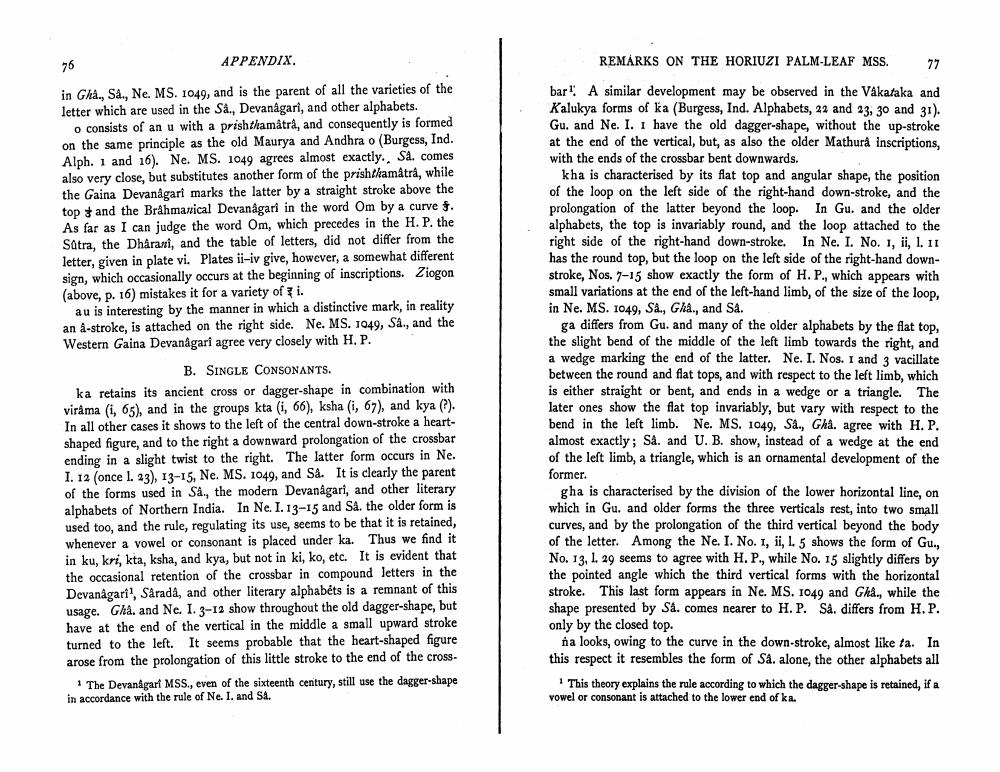________________
76
APPENDIX.
in Gha., Sa., Ne. MS. 1049, and is the parent of all the varieties of the letter which are used in the Sâ., Devanagari, and other alphabets.
o consists of an u with a prishthamâtrâ, and consequently is formed on the same principle as the old Maurya and Andhra o (Burgess, Ind. Alph. 1 and 16). Ne. MS. 1049 agrees almost exactly.. Så. comes also very close, but substitutes another form of the prisht/amâtrâ, while the Gaina Devanagari marks the latter by a straight stroke above the top and the Brahmanical Devanagari in the word Om by a curve §. As far as I can judge the word Om, which precedes in the H. P. the Sútra, the Dharani, and the table of letters, did not differ from the letter, given in plate vi. Plates ii-iv give, however, a somewhat different sign, which occasionally occurs at the beginning of inscriptions. Ziogon (above, p. 16) mistakes it for a variety of i.
au is interesting by the manner in which a distinctive mark, in reality an â-stroke, is attached on the right side. Ne. MS. 1049, Sâ., and the Western Gaina Devanagari agree very closely with H. P.
B. SINGLE CONSONANTS.
ka retains its ancient cross or dagger-shape in combination with virâma (i, 65), and in the groups kta (i, 66), ksha (i, 67), and kya (?). In all other cases it shows to the left of the central down-stroke a heartshaped figure, and to the right a downward prolongation of the crossbar ending in a slight twist to the right. The latter form occurs in Ne. I. 12 (once 1. 23), 13-15, Ne. MS. 1049, and Så. It is clearly the parent of the forms used in Sâ., the modern Devanagari, and other literary alphabets of Northern India. In Ne. I. 13-15 and Så. the older form is used too, and the rule, regulating its use, seems to be that it is retained, whenever a vowel or consonant is placed under ka. Thus we find it in ku, kri, kta, ksha, and kya, but not in ki, ko, etc. It is evident that the occasional retention of the crossbar in compound letters in the Devanagari1, Sâradâ, and other literary alphabets is a remnant of this usage. Ghâ. and Ne. I. 3-12 show throughout the old dagger-shape, but have at the end of the vertical in the middle a small upward stroke turned to the left. It seems probable that the heart-shaped figure arose from the prolongation of this little stroke to the end of the cross
1 The Devanagari MSS., even of the sixteenth century, still use the dagger-shape in accordance with the rule of Ne. I. and Så.
REMARKS ON THE HORIUZI PALM-LEAF MSS.
77
bar. A similar development may be observed in the Vâkataka and Kalukya forms of ka (Burgess, Ind. Alphabets, 22 and 23, 30 and 31). Gu. and Ne. I. I have the old dagger-shape, without the up-stroke at the end of the vertical, but, as also the older Mathurâ inscriptions, with the ends of the crossbar bent downwards.
kha is characterised by its flat top and angular shape, the position of the loop on the left side of the right-hand down-stroke, and the prolongation of the latter beyond the loop. In Gu. and the older alphabets, the top is invariably round, and the loop attached to the right side of the right-hand down-stroke. In Ne. I. No. 1, ii, l. 11 has the round top, but the loop on the left side of the right-hand downstroke, Nos. 7-15 show exactly the form of H. P., which appears with small variations at the end of the left-hand limb, of the size of the loop, in Ne. MS. 1049, Sâ., Gha., and Sa.
ga differs from Gu. and many of the older alphabets by the flat top, the slight bend of the middle of the left limb towards the right, and a wedge marking the end of the latter. Ne. I. Nos. 1 and 3 vacillate between the round and flat tops, and with respect to the left limb, which is either straight or bent, and ends in a wedge or a triangle. The later ones show the flat top invariably, but vary with respect to the bend in the left limb. Ne. MS. 1049, Sa., Ghâ. agree with H. P. almost exactly; Så. and U. B. show, instead of a wedge at the end of the left limb, a triangle, which is an ornamental development of the former.
gha is characterised by the division of the lower horizontal line, on which in Gu. and older forms the three verticals rest, into two small curves, and by the prolongation of the third vertical beyond the body of the letter. Among the Ne. I. No. 1, ii, 1. 5 shows the form of Gu., No. 13, 1. 29 seems to agree with H. P., while No. 15 slightly differs by the pointed angle which the third vertical forms with the horizontal stroke. This last form appears in Ne. MS. 1049 and Ghâ., while the shape presented by Så. comes nearer to H. P. Så. differs from H. P. only by the closed top.
na looks, owing to the curve in the down-stroke, almost like ta. In this respect it resembles the form of Så. alone, the other alphabets all
This theory explains the rule according to which the dagger-shape is retained, if a vowel or consonant is attached to the lower end of ka.




